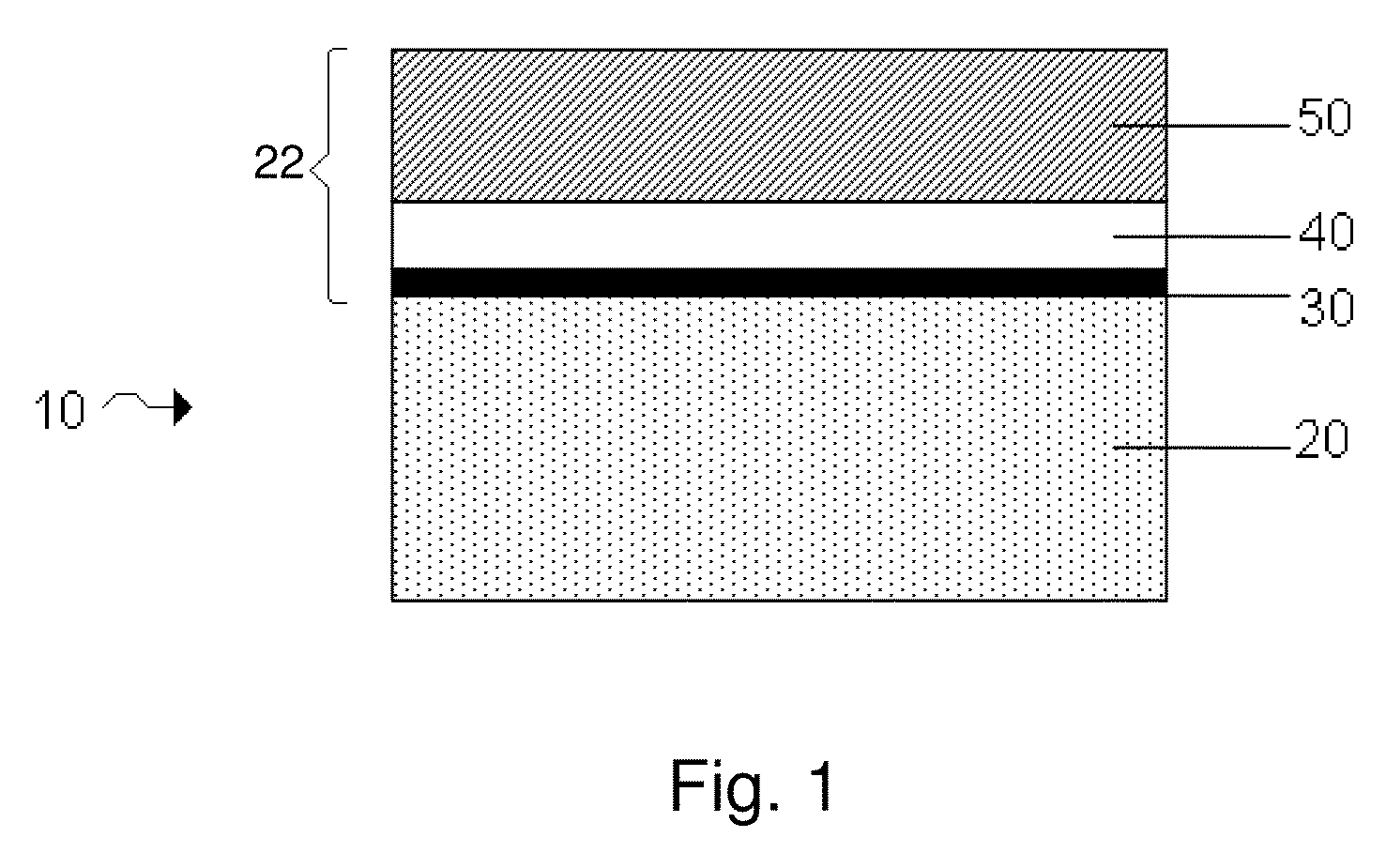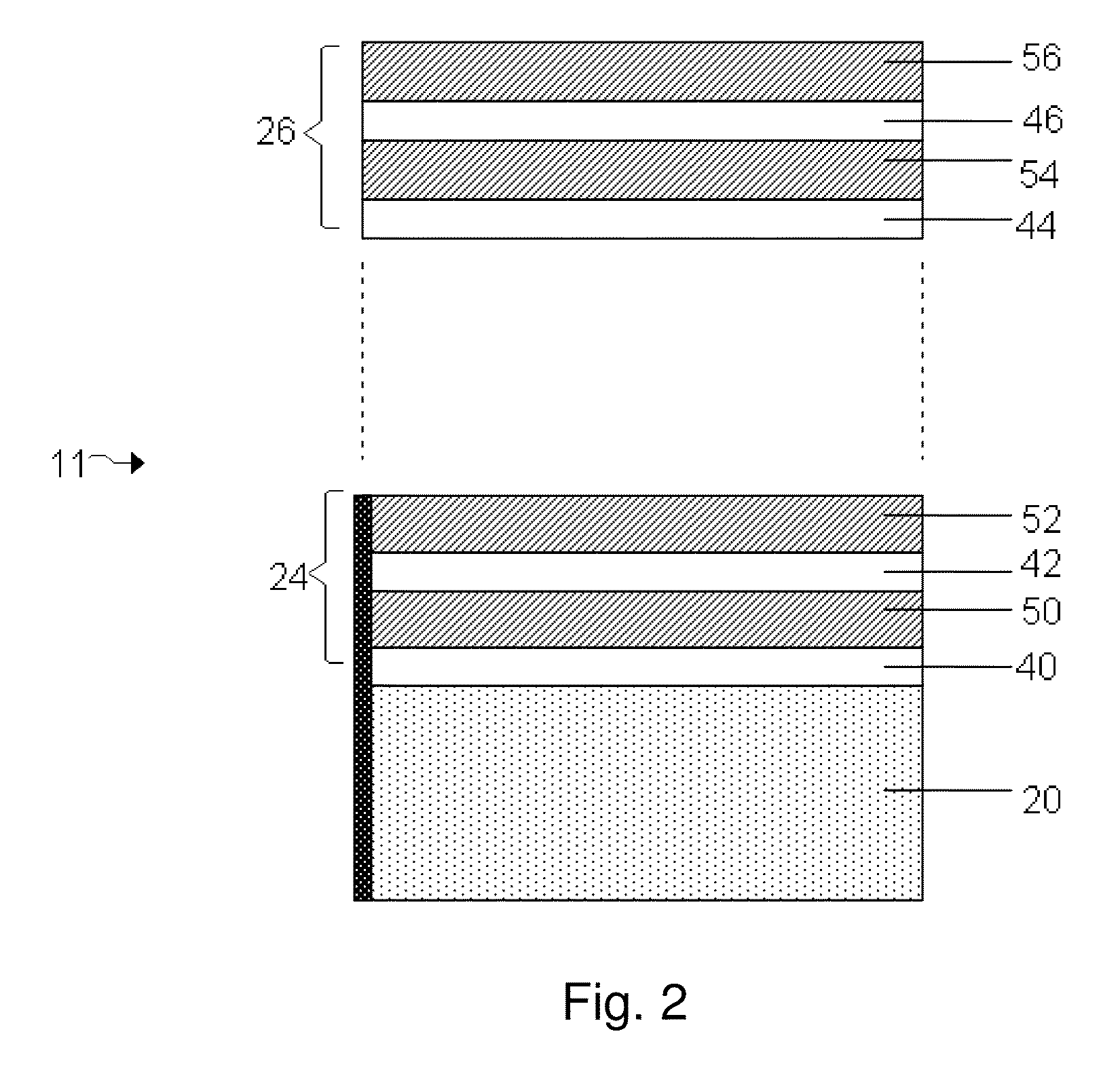Electrode protection in both aqueous and non-aqueous electrochemical cells, including rechargeable lithium batteries
a technology of electrochemical cells and electrochemical cells, applied in secondary cells, cell components, sustainable manufacturing/processing, etc., can solve the problems of premature depletion of li and battery cycle life, interference with charge transport to the underlying, and impede the commercialization of lithium cells. , to achieve the effect of preventing electronic communication
- Summary
- Abstract
- Description
- Claims
- Application Information
AI Technical Summary
Benefits of technology
Problems solved by technology
Method used
Image
Examples
example 1
Fabrication and Characterization of Lamanode Structures
[0124]Lamanode structures, e.g., structures including a first and second layers of Li separated by an embedded layer that is conductive to Li ions, but substantially non-conductive to electrons, were fabricated by thermal evaporation (vacuum deposition) of Li on a PET substrate in two layers of Li with different thickness. The two layers of Li were separated by an embedded layer of a low-conductive material, e.g., LiPON, Li3N or etc. The ratio of the thickness of top and bottom Li layers was calculated based on a required DoD (depth of discharge) of the first discharge and was in the range between 0.2 to 0.4. A layer of about 0.01 to 1 micron LiPON was deposited on top of the bottom thicker Li layer by rf magnetron spattering from a Li3PO4 target in an N2 atmosphere. A thinner Li layer, e.g., 5 microns, was thermally evaporated on top of the embedded layer.
[0125]The top (thinner) Li layer interfacing the electrolyte was dissolve...
example 2
Cycle Lives of Lamanode Structures
[0130]This example shows that the Li cycling efficiency increases and the cycle life is longer for cells including laminode structures compared to cells having single layers of base electrode materials.
[0131]To fabricate control cells, prismatic cells with thermal evaporated Li on one side of 23 micron thickness of PET, Separator Tonen and a cathode containing 65% S coated on one side of a Rexam Al foil were sealed in a bag of Sealright. A mixture of ethers and Li imide salt was used as an electrolyte. The working surface of the anode was 400 cm2. The cells were tasted for cycle life performance at a discharge current of 200 mA to a cut-off of 1.8 V, and charge current of 0.1 A for 4 hours. Cycling results obtained from three control cells were obtained.
[0132]The same cell design as described above was built but with a first laminode anode structure (or “sandwich anode”) instead of a single-layered anode. The first laminode structure included a 20 m...
example 3
Effects of Different Types of Anode Protection on Discharge Capacity
[0137]This example shows effects of different types of anode protection on discharge capacity of a cell.
[0138]The control used in these experiments included a VDLi / CO2 structure, equivalent to a Li foil. A first test structure included a VDLi / CO2 / polymer (1500-2500 Angstroms) structure. A second test structure included a VDLi / CO2 / polymer (1500-2500 Angstroms) structure. A third test structure included a laminode (Sandwich anode) of VDLi / LiPON / VDLi / CO2 / SPE. In this particular experiment, each of the cells were cycled several times, and an improvement of 30-40% in cycle life was obtained when the cell included a polymer layer compared to a cell without a polymer layer. A significant improvement in cycle life was obtained when a cell included an embedded layer of LiPON compared to a cell without an embedded layer. A cell that included a laminode structure having an embedded layer and a polymer layer, e.g., a VDLi / LiPON...
PUM
| Property | Measurement | Unit |
|---|---|---|
| thickness | aaaaa | aaaaa |
| thickness | aaaaa | aaaaa |
| thickness | aaaaa | aaaaa |
Abstract
Description
Claims
Application Information
 Login to View More
Login to View More - R&D
- Intellectual Property
- Life Sciences
- Materials
- Tech Scout
- Unparalleled Data Quality
- Higher Quality Content
- 60% Fewer Hallucinations
Browse by: Latest US Patents, China's latest patents, Technical Efficacy Thesaurus, Application Domain, Technology Topic, Popular Technical Reports.
© 2025 PatSnap. All rights reserved.Legal|Privacy policy|Modern Slavery Act Transparency Statement|Sitemap|About US| Contact US: help@patsnap.com



